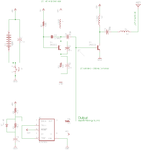RMMK
Full Member level 3
I followed a guide to built a small receiver and transmitter circuit working on 27 Mhz but its range is very small....... I tried to make a half-wave dipole antenna without much success...... I came across a circuit on the internet which seemed quite easy to built and is supposed to amplify my signal....... my question is will it work?? Will it increase the range and is it even a correct circuit diagram??


